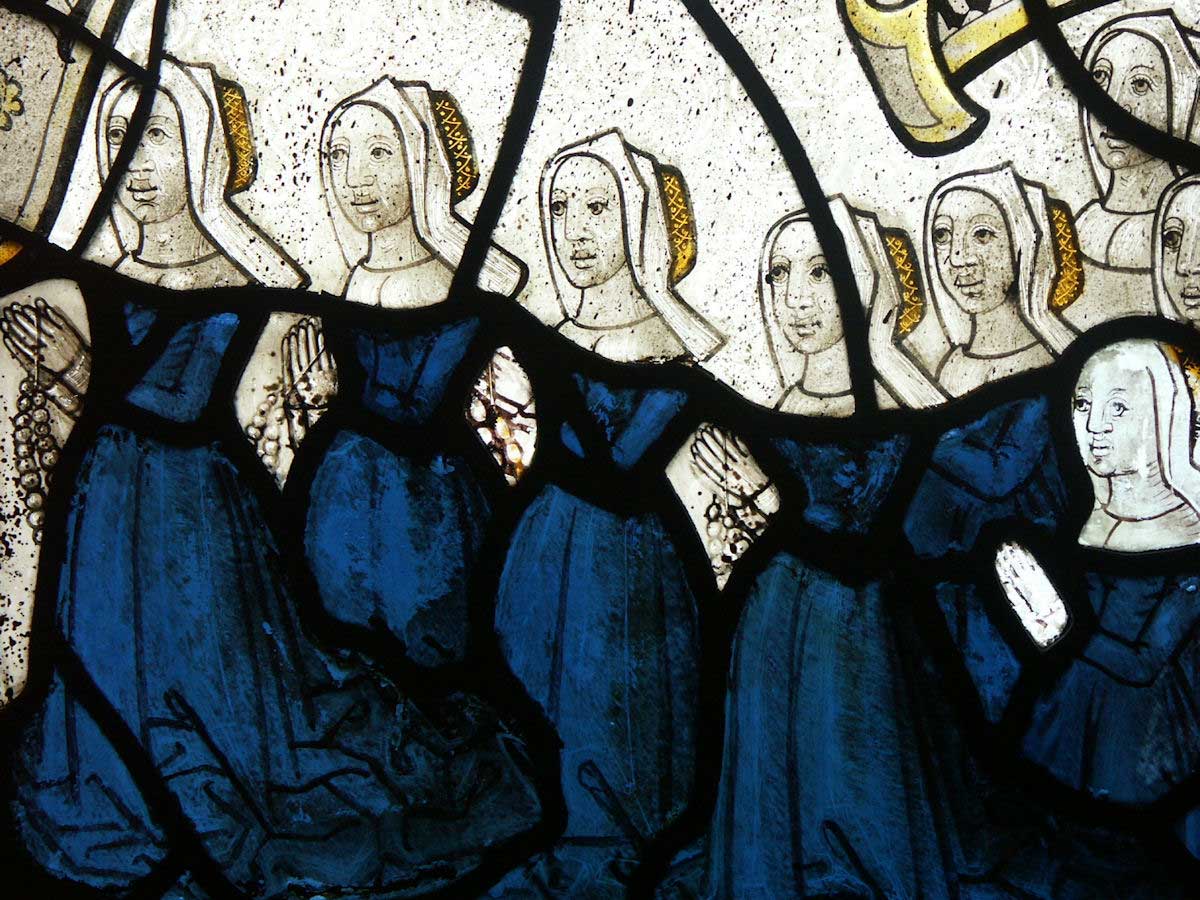cultură şi spiritualitate
The medieval parish church was the meeting point of many different things, both sacred and secular.
 Detail showing a donor group at prayer, church of St Neot, Cornwall. The church has the most complete survival of medieval stained glass in the country. Wiki Commons/Mattana.
Detail showing a donor group at prayer, church of St Neot, Cornwall. The church has the most complete survival of medieval stained glass in the country. Wiki Commons/Mattana.Everyone was meant to go to church in medieval England. Not everyone did. Not everyone could. There were those who needed to work; those who lived too far away; those who had better – or, any rate, other – things to do; those who were not allowed to attend until they had atoned for their sins. In 1426 the parishioners of Coverham in Yorkshire complained that they simply could not gain access to the church because others had taken to filling the porch with swords, bows, arrows and staves before they went in to Mass.
Whether they regularly went or not, the church was an important place for most people in most communities. It was where they could encounter God – literally consuming Jesus’ body in the form of bread and eagerly crying ‘Hold up … heave it a little higher’ or ‘Stoop down ... that I may see my Maker’ as the consecrated host was elevated. It was also where they encountered each other, whether celebrating weddings and baptisms, mourning their dead, or just showing off their Sunday best.
The medieval parish church, as Nicholas Orme shows in his consistently illuminating new book, was the meeting point of many different things: at one and the same time sacred and secular, parochial and universal, temporal and eternal, spiritual and material. No wonder that a place ostensibly devoted to peace caused so many fights. Orme draws on the many records that resulted to paint a complex picture of a complex phenomenon – one that could be found in every community in the land.
Not least of this book’s achievements is that it provides such an expert account of the liturgy and church calendar. Orme describes with great clarity the ‘creeping to the cross’ of Good Friday, the processions – complete with stuffed dragon on a stick – that characterised Rogationtide, the evolution of the Mass, marriage service and much more besides. He is equally assured as he traces the story of church architecture from the small two-roomed structures of the 12th century to the elaborate, lavish, highly ornamented edifices of later years. All of this will be of huge value to those of us who now don’t go to church and to those who do, but still find it hard to tell the rood loft from the reredos or the sursum corda from the Sanctus.
Yet it is perhaps the particular virtue of this book that its author is every bit as interested in the everyday life of the church as he is in the highpoints of sacred theatre and the beauties of medieval architecture. Here are churches filled with the ‘lewd barking, rounding din, and cry’ of animals brought in by their owners. Here are churchgoers who disrupt sanctity with gossip or abuse. The authorities tried to clamp down, but there were always figures like the parishioner who fed holy bread to his dog or another who washed his hands in the font.
This is, in other words, a complete picture of a whole world. It finishes by asking how that world ended and Orme gently counsels against a catastrophist understanding of the 16th century. ‘The Reformation may be likened to a tide washing over a reef’, he argues. ‘At the upper level, the tide carries all before it, but underneath the reef remains.’ It remains in the buildings and in our customs. Even something as intimate and personal as marriage is shaped by this inheritance, not least the placing of a ring on the ‘leech-finger’, which was believed to contain a vein that ran straight to the heart. ‘A medieval church’, Orme observes, ‘was almost as much a place of the dead as it was of the living.’ Perhaps that is still true today.
Going to Church in Medieval England
Nicholas Orme
Yale University Press 496pp £20
Buy from bookshop.org (affiliate link)
William Whyte is Professor of Social and Architectural History at the University of Oxford and the author of Unlocking the Church (Oxford University Press, 2017).
Adaugă un comentariu
© 2024 Created by altmarius.
Oferit de
![]()
Embleme | Raportare eroare | Termeni de utilizare a serviciilor













Pentru a putea adăuga comentarii trebuie să fii membru al altmarius !
Alătură-te reţelei altmarius